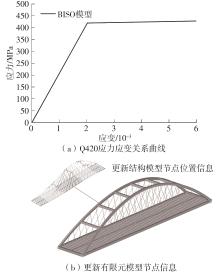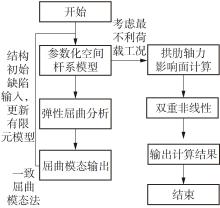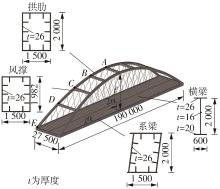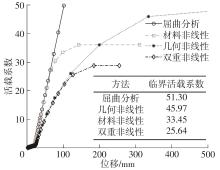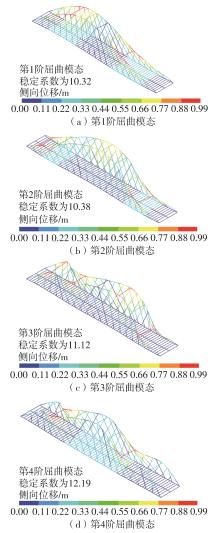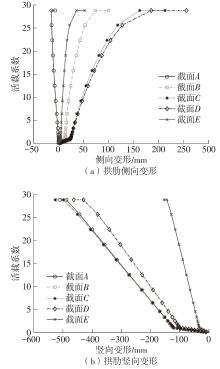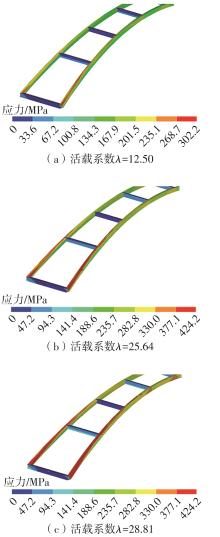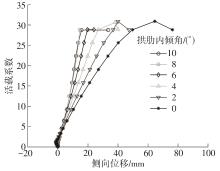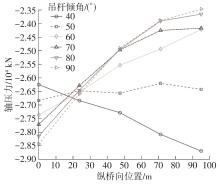Journal of South China University of Technology(Natural Science Edition) ›› 2025, Vol. 53 ›› Issue (8): 111-122.doi: 10.12141/j.issn.1000-565X.240552
• Architecture & Civil Engineering • Previous Articles Next Articles
Stability Analysis of the Network Arch Bridge Considering Nonlinear Effects
JIANG Zuqian1, XIAO Rucheng1, SONG Chaolin1, SUN Bin1, WANG Yeteng1, JIANG Haixi2
- 1.College of Civil Engineering,Tongji University,Shanghai 200092,China
2.Shanghai Chentou Group Corporation,Shanghai 200335,China
-
Received:2024-11-16Online:2025-08-25Published:2025-03-12 -
Contact:孙斌(1977—),男,博士,副教授,主要从事大跨度桥梁结构理论研究。 E-mail:sunbin@tongji.edu.cn -
About author:江祖慊(1996—),男,博士生,主要从事大跨度桥梁结构理论研究。E-mail: zuqianjiang@tongji.edu.cn -
Supported by:the National Natural Science Foundation of China(52378185)
CLC Number:
Cite this article
JIANG Zuqian, XIAO Rucheng, SONG Chaolin, SUN Bin, WANG Yeteng, JIANG Haixi. Stability Analysis of the Network Arch Bridge Considering Nonlinear Effects[J]. Journal of South China University of Technology(Natural Science Edition), 2025, 53(8): 111-122.
share this article
Table 4
Stability analysis results of network arch bridge under different rise-to-span ratio"
| 矢跨比 | 屈曲特征值 | 活载系数 | 运营阶段轴力1)/kN | 失稳临界荷载/kN | 稳定系数 |
|---|---|---|---|---|---|
| 0.10 | 6.50 | 15.76 | 41 757.65 | 284 287.80 | 3.75 |
| 0.13 | 8.02 | 19.06 | 33 868.99 | 330 979.80 | 4.37 |
| 0.16 | 9.30 | 22.36 | 29 255.33 | 377 697.80 | 4.98 |
| 0.18 | 10.32 | 25.64 | 25 533.57 | 424 156.20 | 5.58 |
| 0.21 | 10.75 | 28.90 | 22 778.91 | 470 354.00 | 6.18 |
Table 5
Stability analysis results of network arch bridge under different inclination angle of the arch rib"
| 拱肋倾角/(°) | 屈曲特征值 | 活载系数 | 运营阶段轴力/kN | 失稳临界荷载/kN | 稳定系数 |
|---|---|---|---|---|---|
| 0 | 8.93 | 25.61 | 25 546.21 | 423 732.30 | 5.58 |
| 2 | 9.28 | 25.80 | 25 495.43 | 426 445.26 | 5.61 |
| 4 | 9.63 | 25.99 | 25 476.21 | 429 158.22 | 5.65 |
| 6 | 9.97 | 26.19 | 25 488.78 | 431 871.18 | 5.68 |
| 8 | 10.32 | 26.38 | 25 533.57 | 434 584.14 | 5.72 |
| 10 | 10.65 | 26.57 | 25 611.17 | 437 297.10 | 5.75 |
Table 6
Stability analysis results of network arch bridge under different cables slope"
| 吊杆倾角/(°) | 屈曲特征值 | 活载系数 | 运营阶段轴力/kN | 失稳临界荷载/kN | 稳定系数 |
|---|---|---|---|---|---|
| 40 | 9.59 | 22.43 | 27 825.70 | 378 798.90 | 4.98 |
| 50 | 10.22 | 25.66 | 26 562.69 | 424 438.80 | 5.59 |
| 60 | 10.32 | 25.64 | 25 533.57 | 424 156.20 | 5.58 |
| 70 | 10.14 | 25.62 | 24 967.38 | 423 873.60 | 5.58 |
| 80 | 9.61 | 25.61 | 24 951.10 | 423 732.30 | 5.58 |
| 90 | 9.06 | 25.60 | 24 904.14 | 423 591.00 | 5.57 |
| [1] | 肖汝诚 .桥梁结构体系[M].北京:人民交通出版社,2013. |
| [2] | DANCIU A D, GUTIU S I, MOGA C,et al .A review of the network arch bridge[J].Applied Sciences-Basel,2023,13(19):10966/1-27. |
| [3] | FEDIN K V, GRITSENKO A A, GROMYKO P V .Diagnostics of the stability state of the bugrinsky bridge by acoustic noise method[J].Processes in GeoMedia,2023,6:33-41. |
| [4] | 汤虎,王伟,路辉,等 .济南齐鲁黄河大桥420 m网状吊杆系杆拱桥主拱设计[J].桥梁建设,2022,52(4):117-124. |
| TANG Hu, WANG Wei, LU Hui,et al .Design of arch ribs of 420 m-span network arch main bridge of qilu huanghe river bridge in Jinan[J].Bridge Construction,2022,52(4):117-124. | |
| [5] | 吴丽丽,于雅倩,吕步凡 .波形钢腹板支架拱结构的局部稳定性能[J].华南理工大学学报(自然科学版),2019,47(10):93-104. |
| WU Lili, YU Yaqian, Bufan LÜ .Local stability performance of arch components of underground supporting structure with corrugated steel webs[J].Journal of South China University of Technology (Natural Science Edition),2019,47(10):93-104. | |
| [6] | 张毅,李正良,刘红军,等 .特高压输电塔不等边角钢交叉斜材的承载力[J].华南理工大学学报(自然科学版),2019,47(7):19-31. |
| ZHANG Yi, LI Zhengliang, LIU Hongjun,et al .Study on the stability bearing capacity of unequal angle cross bracing of ultra-high voltage transmission tower[J].Journal of South China University of Technology (Natural Science Edition),2019,47(7):19-31. | |
| [7] | 薛峰,荆克林,段书龙,等 .公路网状吊杆拱桥极限承载力研究[J].公路,2022,67(6):164-168. |
| XUE Feng, JING Kelin, DUAN Shulong,et al .Research on the ultimate bearing capacity of highway mesh suspension arch bridge[J].Highway,2022,67(6):164-168. | |
| [8] | PAN W H, ZHAO C H, WANG C M,et al .Optimal bracing system design for funicular twin arches against out-of-plane buckling[J].Engineering Structures,2024,301:1-12. |
| [9] | JIANG Z, XIAO R, SONG C,et al .An analytical method for out-of-plane stability assessment of network arch bridges[J].Thin-Walled Structures,2024,204:1-17. |
| [10] | 郝天之,李春华,杨涛,等 .索-悬链线拱联合结构的受力机理与力学特征[J].华南理工大学学报(自然科学版),2024,52(8):89-102. |
| HAO Tianzhi, LI Chunhua, YANG Tao,et al .Mechanism and mechanical characteristics of cable-catenary arch combined structure[J].Journal of South China University of Technology (Natural Science Edition),2024,52(8):89-102. | |
| [11] | LAI Y, Li Y, HUANG M,et al .Conceptual design of long span steel-UHPC composite network arch bridge[J].Engineering structures,2023,277:1-19. |
| [12] | WERONIKA O A, ARNE M K .Network arch timber bridges with light timber decks and spoked configuration of hangers-parametric study[J].Engineering Structures,2022,253:1-10. |
| [13] | 曹鑫科 .大跨度网状吊杆拱桥力学性能及结构参数优化研究[D].西安:长安大学,2022. |
| [14] | 钢结构设计标准: [S]. |
| [15] | 公路钢筋混凝土及预应力混凝土桥涵设计规范: [S]. |
| [16] | Eurocode 3:Design of steel structures (Part 2:Steel bridges):UNE—EN 1993-2-2013 [S]. |
| [17] | 刘星星 .网状吊杆拱桥力学行为及极限承载能力研究[D].武汉:华中科技大学,2019. |
| [18] | 曾顺得 .700m跨钢管混凝土拱桥稳定性研究[D].重庆:重庆交通大学,2023. |
| [19] | 康洪滔 .大跨径提篮式钢桁架拱桥非线性稳定研究[D].重庆:重庆交通大学,2024. |
| [20] | LONETTI P, PASCUZZO A .A practical method for the elastic buckling design of network arch bridges[J].International Journal of Steel Structures,2020,20(1):311-329. |
| [21] | 黄云,张清华,叶华文,等 .钢管混凝土系杆拱桥空间稳定性分析[J].桥梁建设,2014,44(4):50-56. |
| HUANG Yun, ZHANG Qinghua, YE Huawen,et al .Analysis of spatial stability of a CFST tied arch bridge[J].Bridge Construction,2014,44(4):50-56. | |
| [22] | 卜一之,赵雷,李乔 .苏通长江大桥结构非线性稳定性研究[J].土木工程学报,2013,46(1):84-91. |
| PU Yizhi, ZHAO Lei, LI Qiao .Structural nonlinear stability analysis of Sutong Yangtze river bridge[J].China Civil Engineering Journal,2013,46(1):84-91. | |
| [23] | 程进,江见鲸,肖汝诚,等 .大跨度拱桥极限承载力的参数研究[J].中国公路学报,2003,16(2):45-47. |
| CHENG Jin, JIANG Jianjing, XIAO Rucheng,et al .Parametric study of ultimate capacity of long-span arch bridges[J].China Journal of Highway and Transport,2003,16(2):45-47. | |
| [24] | 梁岩,罗小勇,欧娅 .大跨径拱桥轴线横向偏差对结构的影响[J].公路交通科技,2013,30(8):92-95. |
| LIANG Yan, LUO Xiaoyong, Ya OU .Impact of transverse axis deviation on structure of long-span arch bridge[J].Journal of Highway and Transportation Research and Development,2013,30(8):92-95. | |
| [25] | TVEIT P .How to design economical network arches[J].IOP Conference Series:Materials Science and Engineering,2019,471(5):052078/1-11. |
| [26] | WANG W, LIN Y, CHEN K .Evaluation of criteria for out-of-plane stability of steel arch bridges in major design codes by FE analysis[J].Applied Sciences-Basel,2022,12(24):12632/1-21. |
| [27] | COSTA B M .Design and analysis of a network arch bridge[D].Lisboa:Instituto Superior Técnico,University of Lisbon,2013. |
| [1] | JIANG Zhengrong, LIU Xiaoliang, SHI Kairong, SU Changwang, ZUO Zhiliang. Stability Analysis of Cable-Supported Cylindrical Reticulated Shells Considering Initial Eccentricity of Members [J]. Journal of South China University of Technology(Natural Science Edition), 2025, 53(4): 22-29. |
| [2] | AN Zhoujian, LI Lu, MAO Shuai, LIU Ligong, DU Xiaoze, ZHANG Dong. Preparation and Thermal Property Regulation of Nitrates Based Phase Change Material for Low and Medium Temperature Thermal Energy Storage [J]. Journal of South China University of Technology(Natural Science Edition), 2025, 53(3): 116-126. |
| [3] | NIU Shifeng, TAI Yinghao, CHANG Dongfeng, YU Pengcheng. Analysis of the Influencing Factors of the Severity of Single-Vehicle Accidents Considering Temporal Stability [J]. Journal of South China University of Technology(Natural Science Edition), 2025, 53(2): 1-11. |
| [4] | HE Yongming, XING Wanyu, WEI Kun, et al. Lane-Changing Trajectory Planning Strategy for Autonomous Vehicles on Superhighways [J]. Journal of South China University of Technology(Natural Science Edition), 2024, 52(4): 104-113. |
| [5] | JI Xiang, WANG Haihong, ZHAI Tiansong, et al.. Global Output Feedback Finite-Time Synchronization Regulation of Robot Manipulators Using Only Position Measurements [J]. Journal of South China University of Technology(Natural Science Edition), 2023, 51(9): 56-68. |
| [6] | BAI Dalian, YANG Lufeng, YIN Yuqi. Generalized Plastic Hinge Method for Ultimate Strength Analysis of Steel Frames Considering Residual Stress [J]. Journal of South China University of Technology(Natural Science Edition), 2023, 51(7): 90-99. |
| [7] | XIA Huiyun, YANG Haotian, LU Changjie, et al. Research on Composition Optimization and Performance of Composite Modified Asphalt Sealant [J]. Journal of South China University of Technology(Natural Science Edition), 2023, 51(6): 136-145. |
| [8] | XIE Pingbo, SHI Ruixue. Study on the Compatibility Between Surface Modifiers of TiO2 Nanoparticles and Orginic Solvents [J]. Journal of South China University of Technology(Natural Science Edition), 2023, 51(6): 129-135. |
| [9] | ZHAO Qiang, LIU Chuanwei, ZHANG Na, et al. Active Disturbance Rejection Control of Active Stabilizer System Based on Particle Swarm Optimization [J]. Journal of South China University of Technology(Natural Science Edition), 2023, 51(6): 52-61. |
| [10] | SUN Ziwen, LIU Jialei. Adaptive Event-Triggered Stability Control for Intermittent DoS Attacks in Industrial Cyber Physical Systems [J]. Journal of South China University of Technology(Natural Science Edition), 2023, 51(3): 146-156. |
| [11] | HUANG Huihua, TANG Lu, LIU Yushan, et al. Preparation of Pineapple Peel Cellulose Nanocrystals and Their Environment Stability in Pickering Emulsions [J]. Journal of South China University of Technology(Natural Science Edition), 2022, 50(8): 1-11. |
| [12] | YAO Qiangqiang, TIAN Ying, WANG Shengyuan, et al. Path Tracking Control Strategy of Intelligent Vehicles Based on Force Drive [J]. Journal of South China University of Technology(Natural Science Edition), 2022, 50(2): 33-41,57. |
| [13] | WU Jiaorong XIE Jinhong WANG Yuqin. Profiling Method of Instability of Bus Route Operation and the Corresponding Application [J]. Journal of South China University of Technology(Natural Science Edition), 2022, 50(2): 15-22. |
| [14] | WU Linping, MA Shangjun, ZHANG Jianxin, et al. Dynamic Analysis of Two-Stage Planetary Roller Screw Mechanism Based on Parameter Matching [J]. Journal of South China University of Technology (Natural Science Edition), 2021, 49(9): 126-134. |
| [15] | ZHANG Yuelong, LOU Wenjuan, CHEN Zhuofu, et al. Aerodynamic Force Characteristics and Wind-Induced Swing Response Analysis of Ellipse Iced Conductor with Ice Bridge [J]. Journal of South China University of Technology (Natural Science Edition), 2021, 49(7): 125-133. |
| Viewed | ||||||
|
Full text |
|
|||||
|
Abstract |
|
|||||
